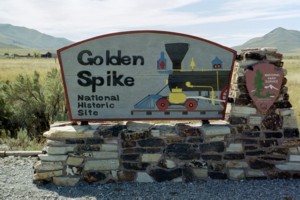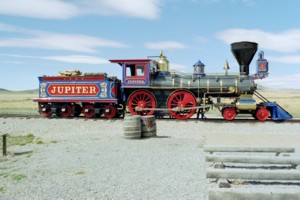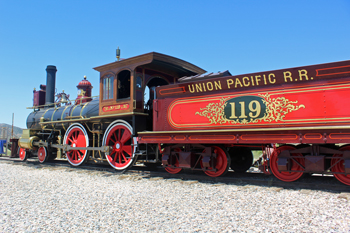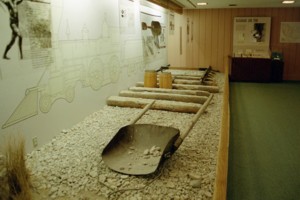This article may include affiliate links. If you click a link and make a purchase, Utah Outdoor Activities may receive a small commission at no extra cost to you. We only recommend products or services we personally use. FTC Affiliate Disclosure.
No sooner were America's first railroads operating in the 1830's than people of vision foresaw transcontinental travel by rail. The idea gained support as a national railroad system took shape. By the beginning of the Civil War, America's eastern states were linked by 31,000 miles of rail, more than in all of Europe. Virtually none of this network, however served the area beyond the Missouri River.

Until the "Great American Desert" and the Rockies were bridged, the vast western territories would be part of the nation in name only. A continent-spanning railroad would also bring more tangible benefits: It would boost trade, shorten emigrant's journey, and help the army control Indians hostile to white settlement. Anticipating great financial and political rewards, northern, Midwestern, and southern senators made their cases for locating the eastern terminus in their regions.
In California, Theodore Judah had his own plan for a transcontinental railroad. By 1862 the young engineer had surveyed a route over the Sierra Nevada and persuaded wealthy Sacramento merchants to form the Central Pacific Railroad. That year Congress authorized the Central Pacific to build a railroad eastward from Sacramento, and in the same act chartered the Union Pacific Railroad in New York. After the Civil War had removed southern senators from the debate over eastern terminus location, the central near the Mormon Trail was chosen, with Omaha as the eastern terminus. Each railroad received loan subsidies of $16,000 to $48,000 per mile, depending on the difficulty of the terrain, and ten land sections for each mile of track laid.

The Central Pacific broke ground in January 1863, the Union Pacific that December, but neither made much headway while the country's attention was diverted by the Civil War. Investors could reap greater profits from the war, and the army had first priority on labor and materials. So Central Pacific's Collis Huntington and Union Pacific's Thomas Durant, exemplars of the no-holds-barred business ethics of the period, visited Washington with enough cash to help congressmen understand their problems. A second Railroad Act of 1864 doubled the land subsidies, but little track was laid until labor and supplies were freed at war's end.
Central Pacific crews faced the rugged Sierra range almost immediately. While the Union Pacific started on easier terrain, its work parties were harassed by Sioux and Cheyenne raiders. With eight flatcars of material needed for each mile of track, supplies were a logistical nightmare for both railroads especially Central Pacific, which had to ship every rail, spike and locomotive 15,000 miles around Cape Horn. Both pushed ahead faster than anyone had expected. The work teams, often headed by ex-army officers, were drilled until they could lay two to five miles of track a day on flat land.

Union Pacific drew on the vast pool of America's unemployed: Irish, German, and Italian immigrants, Civil War veterans from both sides, ex-slaves and even American Indians - 8,000 to 10,000 workers in all. It was a volatile mixture, and drunken bloodshed was common in the "Hell-on-wheels" towns thrown up near the base camps. Because California's labor pool had been drained by the rush for gold, followed by the silver boom, Central Pacific imported 10,000 Chinese, the backbone of the railroad's work force.
By mid-1868 Central Pacific crews had crossed the Sierra and laid 200 miles of track, and the Union Pacific had laid 700 miles over the plains. As the two work forces neared each other in Utah, they raced to grade more miles and claim more land subsidies. Both pushed so far beyond their railheads that they passed each other, and for over 200 miles competing graders advanced in opposite directions on parallel grades. Congress finally declared the meeting place to be Promontory Summit, where, on May 10, 1869, two locomotives pulled up to the one-rail gap left in the track. After a golden spike was symbolically tapped, a final iron spike was driven to connect the railroads. The Central Pacific laid 690 mile of track; the Union Pacific 1,068. They had crossed 1,776 mile of desert, rivers, and mountains to bind together East and West.

A visit to Golden Spike today offers a Museum where the tools and artifacts of the railroads construction are on display, and of course you don't want to miss the two working replicas of the 1860's locomotives 'Jupiter' and '119'. These two locomotives are in operation from May-Labor Day (Schedule subject to change please check www.nps.gov/gosp. Outside the visitor center you can enjoy two auto tours, the West Grade and the East Grade. There is also a easy, flat 1.5 mile/2.4 km trail called the Big Fill Walk. Rangers offer frequent presentations daily from May 31 to September 1.
Every year on May 10 as well as every Saturday and holiday till Labor day the joining of the two railroads is re-enacted (Check www.nps.gov/gosp for updated schedule) . The annual Railroader's Festival is held the second Saturday in August, and the Winter Steam Demonstration and Film Festival are the last weekend in December.
Golden Spike National HistoricPark is located 32 miles west of Brigham City on State Routes 13 and 83. The visitor center is open and accessible 9-5 daily except on Thanksgiving, Christmas and New Years Day. Slide programs, films, and museum exhibits are available for viewing at the visitor center.
Contact Information:
Golden Spike National Historic Park
PO Box 897, Brigham City 84302
Nearby City:
Related Articles:
The Morton Thiokol (ATK) Rocket Display
Nearby Lodging (Affiliate Link):
We hope you enjoyed this information. For more outdoor activities, please connect with us on YouTube, Facebook and Instagram. Help us keep this site up and running by visiting our online store which features outdoor themed gifts, decor and more. Thank you for visiting and for your ongoing support!